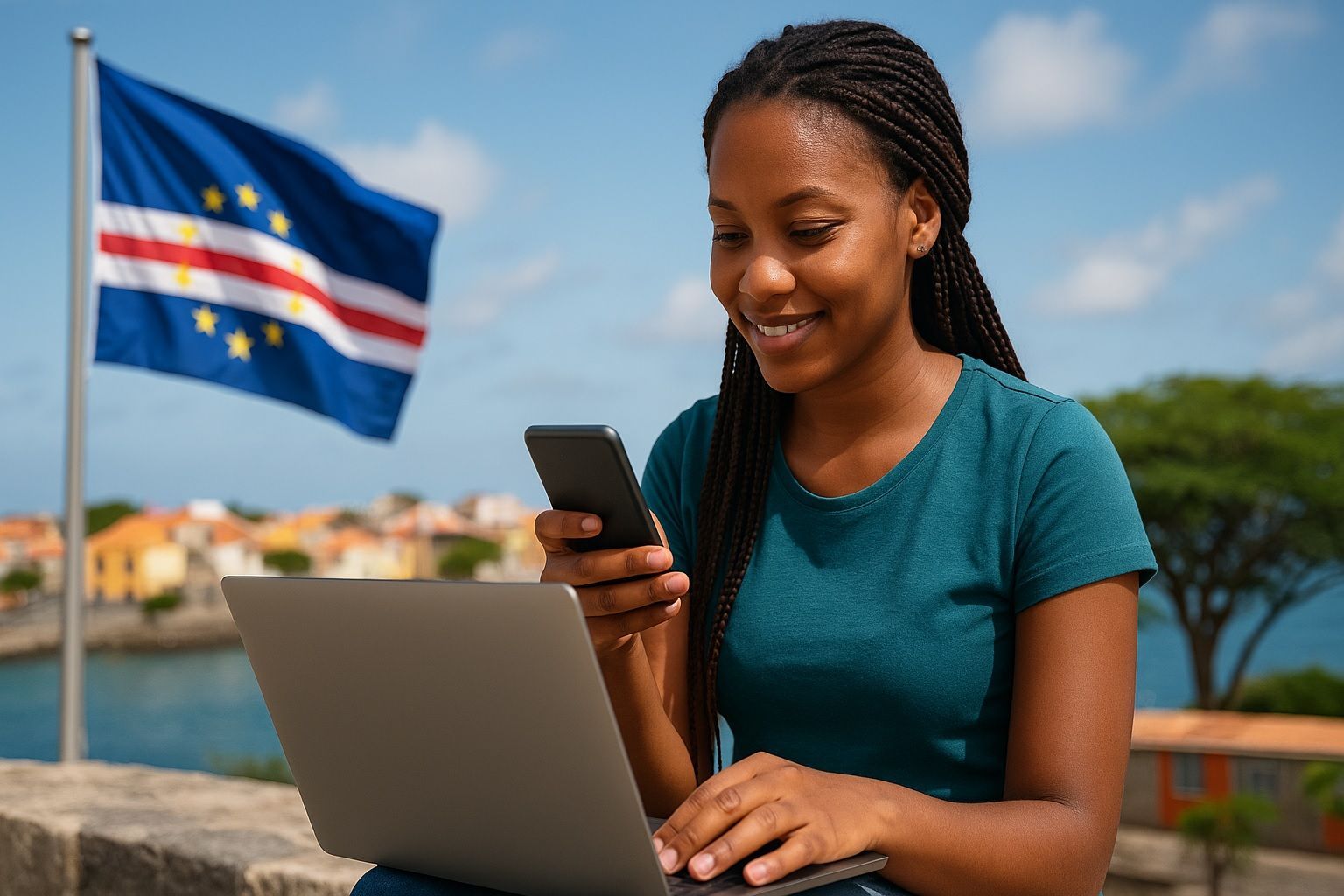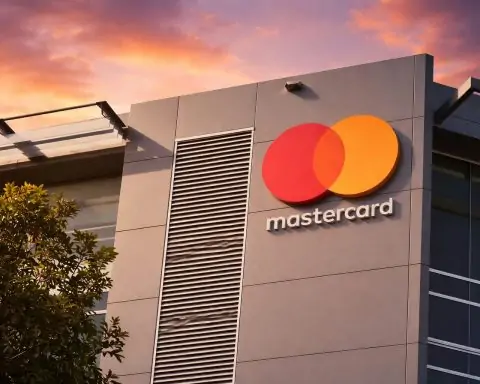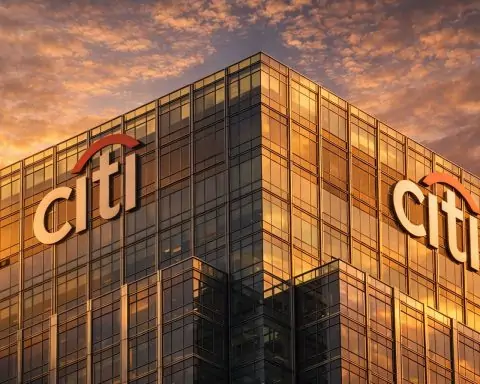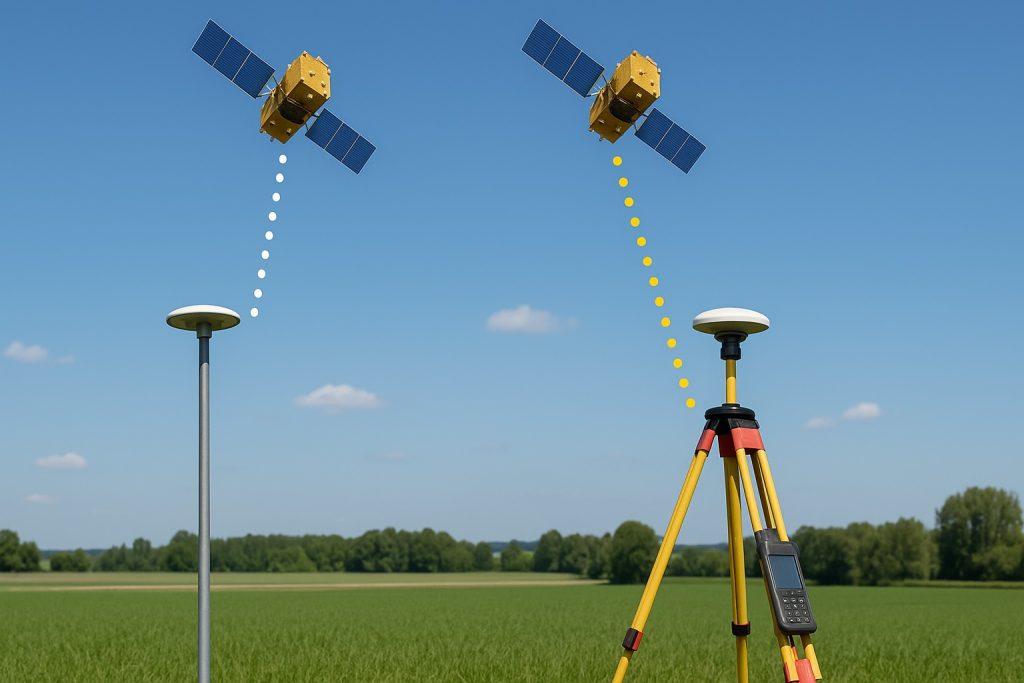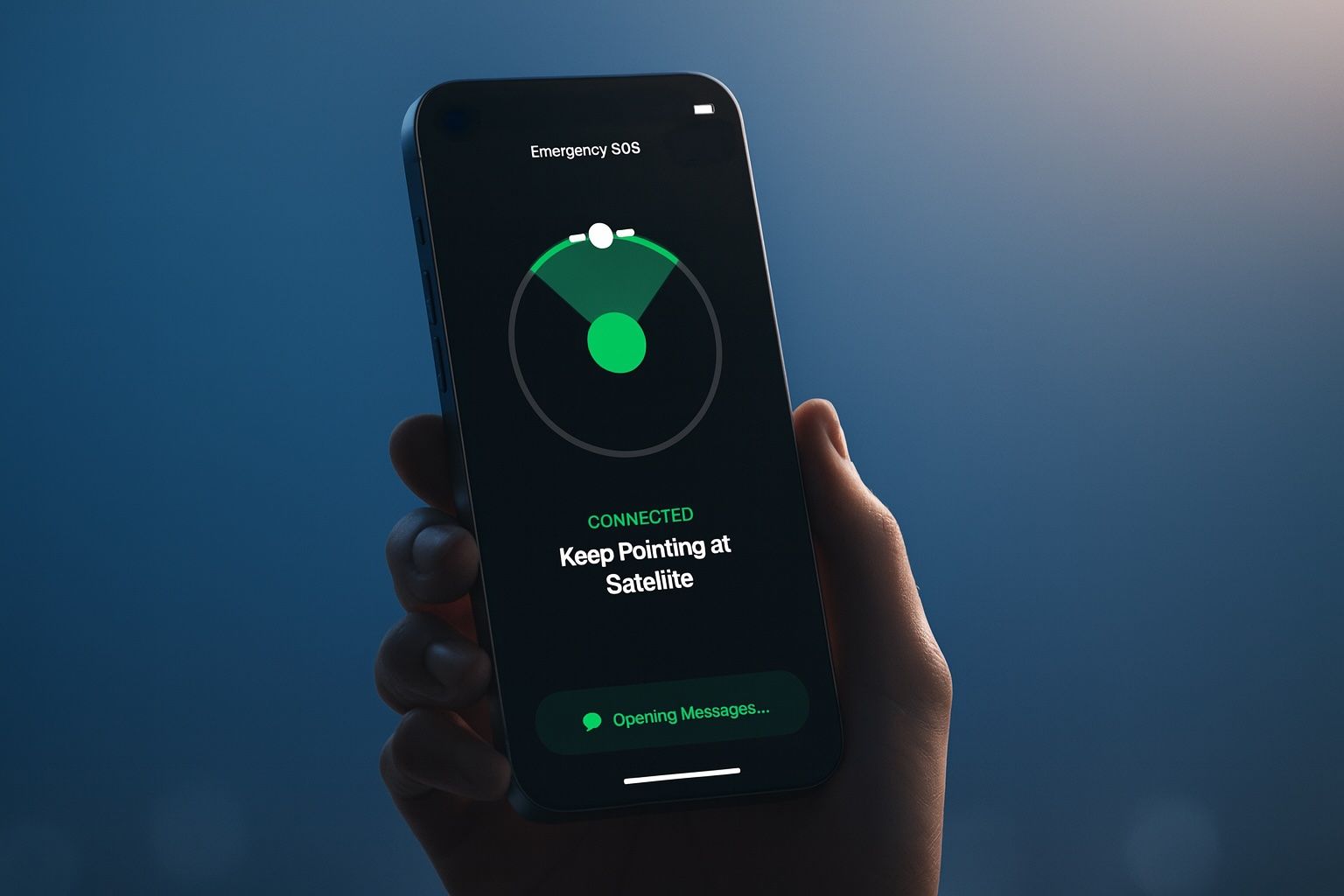- As of early 2025, about 73.5% of Cape Verde’s population were internet users, roughly 387,000 people out of ~526,000.
- Fixed broadband subscriptions totaled about 38,000 in 2023, approximately 7 per 100 people.
- Cape Verde Telecom (CVTelecom) reported passing over 22,000 FTTH homes by the end of 2021, primarily in urban areas.
- There were over 600,000 mobile cellular connections active in early 2025, about 115% of the population, with 91% of connections broadband-capable (3G/4G).
- Total internet subscription density reached about 90 per 100 inhabitants in mid-2023, while around 73% of people were online.
- In early 2024, the median fixed broadband download speed was about 16.4 Mbps, and by early 2025 fixed speeds averaged 19.8 Mbps down / 12 Mbps up, ranking Cape Verde around 133rd globally in Ookla’s index.
- Starlink launched in late 2024 and went live by December 2024, with Standard Residential Plan at CVE 5,000/month and Lite Plan at CVE 3,500/month, and kit costs of CVE 39,000 for the standard dish or CVE 20,000 for a Mini dish.
- Between 2025 and 2026, CVTelecom plans to replace 750 km of end-of-life inter-island fiber with six new submarine cable segments, funded by the EIB, to improve reliability and prepare for 5G.
- Cape Verde gained direct international links via the SHARE cable (Dakar–Praia, about 720 km) completed around 2021 and an Ellalink branch to Praia added in 2021–2022, greatly expanding bandwidth and route diversity.
- The regulator ARME has implemented pro-competition rules including ECOWAS-mandated open access to submarine cable landing stations, enabling competitors to buy capacity at regulated prices and contributing to an 88% reduction in mobile data costs from 2022 to 2023.
Overview of Internet Access in Cape Verde
Cape Verde (Cabo Verde) has made significant strides in expanding internet access across its islands. As of early 2025, about 73.5% of the population are internet users, up from roughly 72% a year prior [1] [2]. In absolute terms, this represents approximately 387,000 users out of a population of ~526,000 [3]. Internet penetration in Cape Verde is among the highest in Africa, more than double the continental average, and is only surpassed by a few small island states like Mauritius and Seychelles [4]. This progress reflects steady growth from near-zero connectivity in the 1990s to today’s relatively widespread usage.
Broadband infrastructure has evolved from basic dial-up and DSL to modern fixed and mobile networks. Fixed broadband subscriptions remain limited in scale (about 38,000 fixed subscriptions in 2023 [5], roughly 7 per 100 people), but have grown rapidly in recent years. During the pandemic (2019–2021) fixed broadband customers surged by 46%, driven by fiber-optic rollouts and higher demand for home internet [6] [7]. Cape Verde Telecom (CVTelecom) reported passing over 22,000 homes with fiber (FTTH) by the end of 2021, primarily in urban areas [8]. Meanwhile, mobile broadband is the primary mode of access for most Cape Verdeans. There were over 600,000 mobile cellular connections active in early 2025 (about 115% of the population) [9], reflecting many users with multiple SIMs. Importantly, 91% of these mobile connections are “broadband” (3G/4G) capable [10]. Thanks to the near-nationwide mobile coverage, total internet subscription density (including mobile data plans) reached about 90 per 100 inhabitants in mid-2023 [11], even though the share of individuals actually online is lower (around 73% of people as noted).
Average connection speeds in Cape Verde are improving but still moderate. In early 2024, the median fixed broadband download speed was about 16.4 Mbps [12], having risen ~11% over the previous year. By comparison, fixed-network speeds averaged around 19.8 Mbps down / 12 Mbps up as of early 2025, ranking Cape Verde ~133rd globally in Ookla’s Speedtest Index [13]. Mobile network speeds tend to be lower: tests in 2025 showed average mobile downloads around 17–18 Mbps on the fastest 4G networks [14]. These speeds suffice for basic web use and HD streaming, but lag global averages. The archipelago’s small market and challenging geography have historically limited infrastructure investments, resulting in capacity constraints. However, ongoing upgrades (fiber deployment, new submarine cables, and now satellite options) are expected to improve speeds and reliability in coming years.
Major Internet Service Providers and Technologies
Cape Verde’s telecom sector is relatively small with a handful of key service providers offering internet access via various technologies:
- Cabo Verde Telecom (CVTelecom) – Branded as “Alô” for consumer services, CVTelecom is the state-backed incumbent operator. It provides fixed telephone, fixed broadband (ADSL and an expanding fiber network), mobile services (through its unit CV Móvel, now under Alô brand), and pay-TV. CVTelecom was historically the monopoly and still dominates the fixed-line market. On the mobile side, it held about 70–71% of active SIM cards as of mid-2023 [15], though this share has been gradually eroded by competition. CVTelecom’s fixed broadband offerings include legacy ADSL in most towns and fiber-to-the-home (FTTH) in parts of Praia (the capital) and other cities. The company often markets “triple-play” bundles (internet, TV, and phone). For instance, unlimited fiber packages with TV and voice are available, advertised as “ultra-fast net” under the Alô brand [16]. While exact pricing varies by speed and bundle, historically fixed broadband in Cape Verde has been relatively costly. CVTelecom has been adjusting its retail prices downward to expand uptake [17]. By 2021, they noted a strong market response to more affordable fixed plans, contributing to the surge in customers [18]. Today, a basic fiber or ADSL plan sufficient for general use might cost on the order of tens of US dollars per month (exact figures depend on promotions and package contents).
- Unitel T+ (T-Mais) – Unitel T+ is the main private competitor, operating since 2007. It is part of the Angolan Unitel group (formerly partly owned by entrepreneur Isabel dos Santos) [19]. Unitel T+ offers mobile services and has also introduced fixed-wireless and fiber offerings in select areas. It launched as Cape Verde’s first alternative mobile operator and now has roughly 29–30% of the mobile market in terms of subscriptions [20]. The company provides 2G/3G/4G coverage across the islands, with a focus on urban centers. Unitel T+ markets some home broadband solutions as well – for example, it has advertised “Quadruple-play” bundles (mobile, fixed internet, TV, and fixed phone in one bill) claiming “the fastest internet on the market” [21]. This suggests Unitel T+ has deployed its own fiber or wireless broadband in competition with CVTelecom, at least in major cities. In practice, Unitel’s fixed internet footprint is smaller than CVTelecom’s, but it may use technologies like LTE-A or point-to-point wireless links to serve businesses and homes. Unitel’s mobile data pricing is competitive; prepaid data bundles and 4G plans are readily available. As of 2023, mobile service prices in Cape Verde have become relatively affordable by global standards – the average cost of a 2GB mobile data/voice basket was around $7.80 per month in 2023, a sharp drop (88% lower) compared to the year prior [22]. This dramatic price improvement is partly due to regulatory pressure and competition (discussed later). For consumers, it means 4G data and voice plans are within reach for most urban users, though rural affordability can still be an issue.
- Other/Minor ISPs – Beyond the two main operators, the internet service market is limited. CVTelecom historically had a subsidiary CVMultimédia that provided cable TV and internet, but as of 2023 CVTelecom merged CVMóvel and CVMultimédia back into a single entity [23] (hence the unified Alô branding). No separate cable company or major third ISP exists; the market is essentially a duopoly. There are, however, some niche providers or resellers offering services like business broadband, VSAT (satellite) for remote clients, and community Wi-Fi. For example, the government’s Technology Park and some NGOs have initiated public Wi-Fi hotspots and school connectivity projects (more in a later section). But for the typical consumer, Alô (CVTelecom) and Unitel T+ are the go-to providers for internet access. Both offer 3G/4G mobile broadband covering all nine inhabited islands, and they compete on fixed internet in the larger towns.
The service quality from these ISPs is generally decent in urban areas and tourist zones, but can be less reliable in remote locations. Users in Praia or Mindelo can get stable broadband (especially on fiber or 4G) with the aforementioned ~15–30 Mbps typical speeds [24] [25]. However, on smaller islands or rural villages, users often rely on older DSL lines or 3G signals, which yield lower speeds (sometimes only a few Mbps) and higher latency. Network congestion has been reported at peak times, as the surge in demand isn’t always met with proportional capacity upgrades. That said, ongoing investments – including 4G expansion and forthcoming 5G trials – aim to boost service quality. (The regulator first licensed 4G LTE in 2019, after pilots on Sal island [26], and both operators have rolled out 4G since then. Plans for 5G are on the horizon; Cabo Verde conducted a 5G test with Huawei in 2019 and aspires to be an early African adopter of 5G [27], though full commercial 5G is not yet live as of 2025.)
Table 1: Key Internet Providers in Cape Verde and Their Services
| Provider (Brand) | Key Services | Technologies | Coverage & Market Share |
|---|---|---|---|
| CVTelecom (“Alô”) | Fixed broadband (ADSL, FTTH), Mobile (CV Móvel), Fixed phone, TV bundles. | ADSL, Fiber (FTTH); Mobile 2G/3G/4G. | Nationwide. ~70% of mobile subscribers [28]. Fiber in major cities; DSL elsewhere. Incumbent operator (state-backed). |
| Unitel T+ (T-Mais) | Mobile services, some fixed wireless and fiber broadband, TV bundles. | Mobile 2G/3G/4G; some FTTx and wireless broadband. | Nationwide mobile coverage (~30% mobile share [29]). Fixed broadband presence in urban areas (competitor to CVTelecom). Angolan-owned private operator. |
| Starlink (new entrant) | Satellite internet (broadband) for homes/businesses. | Low-Earth Orbit (LEO) satellite (SpaceX). | Available countrywide (since Dec 2024). High speeds (50–150 Mbps) even in remote areas. Aims to serve underserved regions. |
(Other minor providers are limited; the market is essentially a duopoly between CVTelecom and Unitel T+, now complemented by Starlink for satellite service.)
Urban vs. Rural Accessibility and the Digital Divide
Cape Verde’s population is split about 69% urban vs 31% rural [30], and this urban-rural divide is reflected in internet access. Urban centers – notably Praia (on Santiago Island) and Mindelo (São Vicente Island), as well as secondary towns like Santa Maria (Sal) or Assomada (Santiago) – enjoy the best connectivity. These areas have higher concentration of fiber-optic lines, 4G cell towers, and public Wi-Fi hotspots. For instance, Praia and Mindelo have been focus points for fiber deployment, with tens of thousands of homes passed [31]. Mobile coverage in cities is strong: both operators provide 3G/4G across urban neighborhoods, and users typically report good signal quality. As a result, internet penetration in urban districts is higher than national average, and many urban residents access the internet through multiple devices (smartphones, home Wi-Fi, work connections). Urban youth and professionals are among the heaviest data consumers, using social media, streaming, and online services heavily – over 69% of internet users in Cape Verde use at least one social media platform [32] [33], a figure likely driven by the urban population with ready connectivity.
In contrast, rural and remote island communities face more challenges. Cape Verde’s geography – an archipelago of 10 islands (9 inhabited) scattered in the Atlantic – means some small or distant islands have sparse infrastructure. Rural villages on islands like Santo Antão, São Nicolau, Maio, Brava, or parts of Fogo might only have basic DSL or 3G coverage. The digital divide often manifests in slower speeds, higher latency, and fewer service options outside the main towns. While nearly every inhabited locality has some mobile signal and thus basic internet capability (2G/3G), the quality may drop off with distance from cell sites. For example, a user in a remote village might only get Edge/3G data or a weak 4G signal, making it difficult to stream video or join a video call reliably. Fixed lines are even less common in rural areas – running fiber or even copper to sparsely populated areas across difficult terrain is costly. As of mid-2023, the internet access penetration was about 90 subscriptions per 100 people nationally [34], but this averages very disparate situations: urban areas often exceed 100% (many having multiple subscriptions), whereas rural penetration is much lower. Indeed, an estimated 26.5% of Cabo Verdeans remain completely offline as of 2025 [35], and these are disproportionately in rural or poorer communities.
Bridging the digital divide has been a policy focus. The government and regulator have partnered with operators and international donors on several initiatives:
- Universal Service Projects: There is a universal service fund mechanism managed by the regulator (ARME) which supports extending telecom services. This has funded things like community telecenters and connecting schools. For instance, programs to equip schools with internet and improve connectivity in public institutions on outer islands have been implemented, often with World Bank or UN support [36]. Rural schools and health centers have been connected via satellite or wireless links in some cases.
- Inter-island Backbone Improvements: To ensure even the smaller islands have reliable backhaul, Cape Verde has invested in inter-island fiber and microwave links. A major inter-island submarine fiber network (the “Atlantis” cables and others) has existed for years, but segments have aged. In late 2024, CVTelecom launched a tender to replace 750 km of inter-island fiber cables that were at end-of-life [37]. This project, co-financed by the European Investment Bank (EIB), will install six new submarine cable segments connecting the islands, with work expected 2025–2026 [38]. The goal is to improve reliability and capacity between islands, which in turn benefits rural users by reducing outages and contention. It’s explicitly aimed at “responding to growing demand and ensuring the network is reliable,” as well as preparing for future 5G rollout across all islands [39].
- Mobile Coverage Expansion: Both telecom operators have obligations to cover all populated areas. By 2020s, virtually all localities have at least basic coverage, but efforts continue to upgrade 2G-only areas to 3G/4G. The government has pushed for 4G coverage beyond just the main cities; since the licensing of LTE, operators have gradually expanded 4G to smaller towns. Some very remote spots (e.g. mountainous villages or less-visited islands like Brava) might still lack 4G, but these gaps are closing as Unitel and CVTelecom invest in network expansion (often with tax incentives or donor funding). Satellite solutions (discussed below) are also emerging as a way to reach the most isolated users.
- Public Wi-Fi and Community Access: Cape Verde has also tried to create community access points. There have been projects like “Casa do Cidadão” telecenters, and more recently, some city halls offer free Wi-Fi zones (e.g., in plazas of Praia or Mindelo). The Internet Society and local tech groups have worked on establishing an Internet Exchange Point (IXP) in Cape Verde to improve local traffic and on training local technicians [40]. Strengthening local infrastructure indirectly benefits rural users by improving overall network performance and reducing dependency on expensive international links.
Despite these efforts, challenges remain: relatively high poverty rates and low digital literacy in some rural areas mean that even where internet is available, not everyone can make full use of it. Devices (smartphones, computers) and tech skills are needed to truly benefit. The government’s “digital inclusion” programs therefore also focus on training and affordable device initiatives. Notably, the introduction of cheaper mobile data plans (as evidenced by the steep price drop in 2023 [41]) and now affordable satellite options are promising for rural inclusion. The hope is that by combining terrestrial network expansion with satellite coverage, 100% of Cape Verde’s population can have at least basic internet access in the near future.
Emergence of Satellite Internet Services
One of the most exciting recent developments is the arrival of satellite broadband services in Cape Verde. In late 2024, SpaceX’s Starlink service officially launched in the country, offering high-speed internet via low-earth orbit satellites. This marks a new chapter for connectivity, especially for remote and underserviced areas.
[42] [43]Starlink received approval from the national regulator (ARME) in October 2024 and went live by December 2024, making Cape Verde the 18th African market for Starlink. The service is provided through a local entity (Starlink Cape Verde) and has authorization to operate nationwide [44]. Starlink’s arrival is seen as complementary to existing terrestrial networks – it can bring broadband to rural villages, outer islands, and boats/ships, all of which previously had to rely on slow or expensive links. ARME supported Starlink’s entry as part of its mandate to foster competition and improve service quality for residents, highlighting that satellite internet can help bridge digital gaps and connect underserved areas [45].
In terms of performance, Starlink has demonstrated impressive speeds in Cape Verde. During Q1 2025, user tests showed Starlink achieving average download speeds around 115.7 Mbps (far above the ~20–30 Mbps of local fixed broadband), with uploads ~11 Mbps and latency ~90 ms [46]. This makes it the fastest broadband option in the country by download speed [47]. The latency (~90 ms) is higher than local fiber but still much better than traditional geostationary satellites, enabling video calls and streaming. Essentially, Starlink can deliver true broadband to places that never had it – a game changer for, say, a small business on an outer island or a remote school needing reliable internet.
Starlink’s pricing in Cape Verde has been set with two tiers to cater to different needs [48]:
- Standard Residential Plan – CVE 5,000 per month (approximately USD $48). This provides regular high-speed connectivity with unlimited data usage. It is comparable to Starlink’s standard offering globally and promises the full speeds (50–200 Mbps range) when capacity allows.
- Residential “Lite” Plan – CVE 3,500 per month (~USD $34). This is a more affordable option with unlimited data but deprioritized bandwidth during peak times. In practice, Lite users may experience slower speeds if the network is busy, but still get broadband access. This tier was introduced to make satellite internet accessible to smaller households or those with budget constraints [49].
The hardware cost for Starlink is a one-time fee: the standard Starlink kit is CVE 39,000 ($373 USD), and interestingly a smaller “Mini” dish is offered at CVE 20,000 ($191) for those who want a lower-cost setup [50]. These prices, while not cheap in absolute terms, are competitive considering Cape Verde’s context – historically, a VSAT satellite connection could cost many hundreds of dollars per month for much less bandwidth. Now for around $34–48/month, even a remote household can have broadband, which is quite revolutionary.
Early adoption of Starlink in Cape Verde is still in nascent stages (given it just launched in late 2024). Tech enthusiasts, some businesses, and government agencies were among the first to order kits. Over time, adoption is expected to grow, particularly in areas where CVTelecom or Unitel signals are weak. For example, the island of Maio or parts of rural Santo Antão might see community centers or hotels opting for Starlink to serve their clients. Even in well-covered areas, some enterprises might use Starlink as a backup or for additional bandwidth. The government is also interested in leveraging satellite connectivity for resilience – Starlink can provide backup internet during undersea cable outages or emergencies (useful in hurricane season or if a cable cut isolates the country). Notably, ARME’s approval of Starlink aligns with a broader African trend of embracing LEO satellites to reach universal access.
Beyond Starlink, other satellite options include legacy geostationary services (e.g., Intelsat, SES bandwidth resold by local ISPs) which have been used in the past by banks or telecom for redundancy. However, these were typically limited due to high latency (600+ ms) and cost. No local Cape Verdean satellite operator exists – instead the focus is on partnerships with global providers. It’s worth mentioning that Project SHARE, a Senegal-Cape Verde initiative, landed a cable in 2021 which reduced dependency on satellites for international connectivity [51], but for local last-mile in remote zones, satellite remained an option. Now with LEO systems (Starlink, and potentially others like OneWeb in future), satellite is moving from a niche last-resort to a mainstream alternative for broadband.
In summary, the development of satellite internet in Cape Verde – led by Starlink – greatly expands the menu of connectivity options. It offers performance on par with urban fiber connections and brings high-speed internet to any point in the country with a clear view of the sky. While cost may still be a hurdle for poorer households, the competitive pricing and unlimited data of Starlink are very appealing. Over the next few years, satellite broadband adoption could rise, especially if device costs drop further. The presence of Starlink also exerts competitive pressure on local ISPs to improve their services and prices (a benefit noted by ARME in approving Starlink [52]). Ultimately, satellite internet is set to play a key role in Cape Verde’s strategy to achieve universal internet coverage and strengthen network resilience.
Infrastructure and Policy Support for Internet Development
The Cape Verdean government, through policies and partnerships, has actively supported the expansion of digital infrastructure. A combination of national initiatives and international support has been crucial for the progress in internet access. Key areas of focus include international connectivity, domestic backbone upgrades, pro-competition regulation, and strategic investments:
- International Connectivity: Being an island nation, Cape Verde relies on submarine fiber optic cables for global internet access. Historically connected by the SAT-3 and Atlantis-2 cables, the country significantly boosted its international bandwidth in recent years. A new direct submarine cable link to Africa was established via the Senegal Horn of Africa Regional Express (SHARE) cable, a 720 km system between Dakar (Senegal) and Praia, completed around 2021 [53]. This cable provides a design capacity up to 16 Tbps between Cape Verde and the African continent [54]. Additionally, Cape Verde obtained a branch on the Ellalink cable (connecting Europe to Brazil) around 2021–2022, which links Praia into a transatlantic fiber route [55] [56]. These new connections greatly increased available bandwidth and introduced route diversity (previously, WACS – West Africa Cable System – was a primary route and any issue there could severely impact Cape Verde [57]). As a result, Cape Verde’s international internet bandwidth has been growing by ~43% annually, with a projected six-fold capacity increase from 2023 to 2027 [58]. More capacity and redundancy mean lower latency and wholesale costs, benefiting consumers.
- Wholesale Price Reductions and Regulation: The national regulator ARME (Agência Reguladora Multissectorial da Economia) has implemented pro-competition policies to lower costs. Notably, the government adopted an ECOWAS regional decree that mandates fair and open access to submarine cable landing stations [59]. This forced the incumbent CVTelecom to offer capacity to competitors like Unitel T+ at regulated prices. As a result, wholesale internet bandwidth prices dropped dramatically – to about one-eighth of their previous level after these interventions [60]. CVTelecom initially resisted sharing its cable landing (even mulling litigation in 2020 when ARME ordered it [61] [62]) but ultimately complied. This open access regime has been pivotal: Unitel T+ and others can purchase international bandwidth cheaply, which in turn has driven down retail internet tariffs. The dramatic 88% reduction in average mobile data cost from 2022 to 2023 [63] is one outcome. ARME also regulates mobile termination rates and encourages healthy competition – as evidenced by allowing Starlink’s entry and planning for a possible third operator or MVNOs in the future. All these efforts aim to make internet access more affordable and of higher quality for end-users.
- Investments in National Backbone: The government, CVTelecom, and international financiers have invested in modernizing the domestic network. The Digital Cabo Verde Project, co-funded by the World Bank, includes components for improving connectivity and e-government. The World Bank has put tens of millions of dollars (including a $20M additional financing in 2023) into Cape Verde’s digital development, which covers upgrading the inter-island fiber backbone, expanding rural connectivity, and strengthening institutions [64]. The European Investment Bank (EIB) too supported a major program – in 2018 it approved the Cape Verde Connectivity Programme, financing €22 million (out of €53M project) for CVTelecom to extend fiber (FTTx) and 3G/4G mobile networks, and to land the new submarine cable branch [65] [66]. This program’s objective was to bring Cape Verde’s telecom services up to “international state-of-the-art standards” by expanding high-speed broadband and reinforcing international links [67]. Additionally, Chinese partners (Huawei Marine, now HMN Tech) were involved in deploying the SHARE cable [68] and likely the inter-island cable upgrades, illustrating a mix of international partnerships.
- Policy Framework and Digital Strategy: Cape Verde has a clear strategic vision to become a “digital economy” hub in West Africa. The government’s Digital Agenda and related policies (often referred to under initiatives like “Cabo Verde Digital”) emphasize ICT infrastructure, digital inclusion, and e-services. A Technology Park was launched to incubate tech businesses and improve internet access services [69]. Moreover, the country leverages its stable democracy and educated population to attract IT investment, which in turn creates demand for better connectivity. On the policy front, data protection, cybersecurity, and internet governance have also seen development – e.g., Cape Verde scores very high (96.9) on ITU’s Global Cybersecurity Index in Africa [70], showing government commitment to a robust digital environment.
In summary, government and international support have been integral to Cape Verde’s internet progress. By funding critical infrastructure (cables, fiber, towers), enforcing pro-competition rules, and embracing new technologies (like satellite and future 5G), Cape Verde’s policymakers and partners are creating an enabling environment for internet growth. The results are evident in the improved metrics: more coverage, higher speeds, and falling consumer prices. There is a virtuous cycle in play – better infrastructure leads to more users and usage, which attracts further investment. Challenges remain (small market size, need for continuous upgrades, and ensuring the last segments of the population get online), but the trajectory is positive. Cape Verde today stands as a leader among small states in Africa in terms of internet access, thanks in large part to these concerted support efforts.
Historical Progress and Future Projections
Historical trajectory: Two decades ago, Cape Verde’s internet landscape was minimal – in the early 2000s, internet penetration was only a few percent and mostly via dial-up or slow VSAT links. The national telecom began offering DSL broadband in mid-2000s, and mobile internet started with GPRS/EDGE. A significant turning point was the landing of the first high-capacity submarine cable (WACS) in 2011, which dramatically increased international bandwidth. By the mid-2010s, 3G mobile internet had spread and DSL covered most towns, pushing internet penetration into the few tens of percent. The late 2010s and early 2020s then saw accelerating growth: the introduction of 4G (licensed in 2019 [71]), major investments in fiber and mobile expansion, and a focus on digital services by the government. From 2017 to 2023, the proportion of individuals using the internet jumped from about 57% to over 73% [72] [73] – a testament to these efforts.
Key milestones in the historical development include:
- 1998: CVTelecom launches dial-up internet access (very limited uptake).
- 2004: First submarine cable (Atlantis-2) connection; still, internet users <5%.
- 2006-2008: ADSL broadband introduced; mobile operators begin data (2.5G) services.
- 2011-2012: WACS submarine cable and others go live, boosting capacity; 3G networks roll out. Internet users exceed 20%.
- 2013: Unitel T+ enters mobile internet market aggressively, increasing competition.
- Mid-2010s: Growth of social media and smartphones; by 2017 internet penetration ~57% [74].
- 2019: 4G LTE licensed and piloted; government commits to 5G trials [75] [76].
- 2020-2021: Pandemic drives up demand; CVTelecom accelerates fiber rollout, achieving 22k FTTH home passes [77]; fixed internet subscriptions surge ~20% annually [78].
- 2022-2023: New international cables (SHARE, Ellalink branch) operational, alleviating bandwidth bottlenecks; ARME’s regulatory moves drastically cut wholesale costs [79], making internet more affordable. Penetration crosses 70%.
- 2024: Starlink and other innovations appear; Cape Verde holds its first Internet Governance Forum (IGF-CV) focusing on digital resilience [80].
Looking ahead to the future, Cape Verde’s outlook is very promising. Several projections and plans can be highlighted:
- Further Increases in Penetration: The remaining roughly one-quarter of Cape Verdeans who are offline are expected to shrink. With affordability improving and infrastructure reaching more remote areas (via fiber or satellite), the country could realistically approach universal internet access (~90%+ of individuals online by late 2020s). A World Bank analysis suggested that improved bandwidth and lower prices could directly lead to thousands of new internet users each year beyond current trends [81]. Reaching the last 10–15% (often the oldest or most isolated citizens) will be the toughest, but initiatives around digital literacy and community access will continue to address this.
- 5G Introduction: Within the next few years, we can expect 5G mobile networks in Cape Verde’s cities. The government’s ambition is to be among Africa’s early adopters of 5G [82]. Trials with vendors like Huawei have already been planned. Given the small size of cities, a focused 5G rollout (perhaps in Praia or Sal island’s tourism hubs) could happen by 2025–2026. 5G would enable very high speeds (theoretically 10x 4G speeds) and low latency, which might spur new services (IoT, advanced wireless broadband, etc.). However, 4G still has plenty of room to expand and will remain the workhorse for nationwide coverage in the near term.
- Network Resilience and Capacity: By around 2026, the new inter-island fiber network (CSII-4 project) is slated to be completed [83]. This will modernize the domestic backbone and support growth for decades. Internationally, Cape Verde might get involved in additional cable systems – e.g., the 2Africa megacable (circum-Africa system) has a branch to nearby regions and could potentially benefit Cape Verde [84]. With multiple cables in place, the country is better protected from outages; the infamous scenario of a single cable cut causing nationwide internet blackout should be avoided. The focus will also shift to increasing last-mile capacity: more fiber-to-the-home in cities, possibly fixed 5G wireless for suburbs, and leveraging Starlink for hard-to-reach spots.
- Service and Market Developments: On the consumer side, expect improved service offerings. For instance, fiber broadband speeds will likely increase (the current 30–50 Mbps top tiers could become 100 Mbps or more as fiber and backhaul capacity grow). Prices may continue to fall or data caps removed – already we see unlimited data options on both fixed (Alô’s fiber plans) and mobile (Unitel offers generous 4G bundles, Starlink is unlimited). There is also scope for new entrants or mobile virtual network operators (MVNOs) to appear, which could further drive innovation and prices. The regulator ARME has hinted at promoting more competition if needed to keep the incumbents on their toes.
- Digital Economy Growth: Improved internet access positions Cape Verde to grow its digital economy. We can foresee more e-government services (building on the already solid e-governance framework), growth in tech startups or outsourcing (Cape Verde could attract BPO or remote work hubs due to its connectivity and multilingual educated workforce), and expansion of ICT-related tourism (e.g., attracting digital nomads looking for tropical locales with good internet – an area where the country is already marketing itself, though current ratings point out the need for even better speeds and coworking facilities [85] [86]). Cape Verde’s strategy aligns with other small nations that leverage good connectivity for economic diversification, much like Mauritius has done.
- Comparative Standing: In the future, Cape Verde is poised to maintain or improve its standing relative to peers. Among small island developing states (SIDS), it is already a leader in Africa and holds its own globally. For example, internet usage (~73%) is now on par with or higher than many Caribbean islands and Pacific islands of similar size, though still behind the very high levels of some (Seychelles ~87% [87], Barbados ~80%+, etc.). In terms of broadband speed, there’s room to catch up to places like Mauritius, which enjoys higher fiber penetration and thus higher average speeds (~35–40 Mbps). Cape Verde’s ongoing fiber upgrades and the competitive jolt from Starlink should close that gap. By many indices (such as the ITU ICT Development Index or Network Readiness Index), Cabo Verde is expected to continue ranking highly in its income group. It has been praised for its ICT regulatory environment and cyber security, while the main improvements needed are in infrastructure and skills – both actively being addressed.
In conclusion, Cape Verde’s internet access story is one of remarkable progress for a small, dispersed island nation. From very limited connectivity just 15–20 years ago, it has achieved relatively widespread internet availability and is at the forefront of adopting new solutions (like satellite broadband) to reach everyone. Government policy, a competitive telecom market, and international partnerships have all been key to this success. Challenges like the urban-rural divide and maintaining affordability are recognized and being tackled through strategic projects and regulations. If current trends continue, Cape Verde will likely serve as a model for digital development among small island states, demonstrating how even remote regions can leapfrog into the global digital economy with smart investments and inclusive policies.
Comparative Perspective with Similar Small Island Nations
To put Cape Verde’s internet landscape in context, it’s useful to compare it with other small island countries, whether in Africa or elsewhere, that face similar challenges of remoteness, scale, and resource constraints. Below is a brief comparative analysis on a few key metrics:
- Internet Penetration: Cape Verde’s ~73% internet usage rate is one of the highest in Africa. It is ahead of other Atlantic islands like São Tomé and Príncipe (~62% [88]) and the Comoros (which is significantly lower, under 20% users). In the African context, only Mauritius and Seychelles have comparable or higher rates – Mauritius was at about 75–80% in 2024 [89], and Seychelles around 86% [90]. These three (Seychelles, Mauritius, Cabo Verde) form the top tier of African SIDS for connectivity. Globally, many Caribbean small states (e.g. Barbados, Bahamas, etc.) report internet penetration between 70% and 80%, quite similar to Cape Verde. Pacific small states vary widely (some like Fiji around 65%, others much lower). So Cape Verde now clearly falls into the upper range of internet penetration among small islands, and it has doubled its rate from about 35% a decade ago to over 70% today.
- Broadband Coverage and Speed: In terms of broadband infrastructure, small islands often rely heavily on mobile networks. Mobile broadband (3G/4G) coverage in Cape Verde is extensive (~98% population coverage for basic 3G, with 4G quickly expanding since 2019). This is comparable to Mauritius (which has near 100% LTE coverage) and Seychelles. It outpaces some other islands where geography is tougher – for instance, Vanuatu or Solomon Islands have far more gaps. Fixed broadband coverage in Cape Verde (ADSL or fiber) is mostly urban-centric; similarly, in Seychelles most fixed lines are on the main island Mahé, and in Mauritius fiber is widespread on the main island but Rodrigues island has less. In absolute speed rankings, Cape Verde’s median fixed speed ~16 Mbps [91] trails Mauritius (which often clocks 30+ Mbps median, thanks to a high fiber-to-the-home uptake) and also trails Seychelles (Seychelles has invested in fiber and LTE-A, yielding around 20–25 Mbps averages). However, with the advent of Starlink’s 100 Mbps+ capability, Cape Verde has an equalizer – few small islands have such an option yet (though Starlink is also expanding to many). For mobile speeds, all these islands are somewhat similar in the mid tens of Mbps (all are limited by 4G technology and small markets).
- Pricing and Affordability: Insular markets often suffer high internet prices due to lack of scale and competition. Cape Verde historically had expensive rates (as indicated by the high cost prior to 2023), but recent regulatory moves have brought prices down significantly [92]. At $7.80 for a 2GB mobile basket [93], Cape Verde actually enjoys cheaper mobile data (in absolute USD) than many African countries – for comparison, that price is lower than the African average and even slightly better than Mauritius’s average mobile data costs. When considering income levels, the cost of internet in Cape Verde is about 2.1% of GNI per capita for the mobile basket, which is quite affordable relative to the ~5% global average [94]. Small islands like Seychelles and Mauritius, having higher per-capita incomes, also fare well on affordability despite higher absolute prices. On the other hand, in places like São Tomé or the Pacific islands, internet can consume over 10% of monthly income for a basic package – highlighting that Cape Verde is doing fairly well in making internet affordable to its citizens (partly due to competition and subsidized wholesale rates).
- Infrastructure and Initiatives: Many small island states rely on a couple of submarine cables and often have satellite backups. Cape Verde’s strategy of securing multiple cables (to Europe, Africa, Latin America) is akin to Mauritius which has multiple submarine cable landings, and Seychelles which connected to two submarine cables (SEAS and PEACE cables). This redundancy is crucial for resilience. Smaller or poorer islands often struggle to get a second cable due to cost, leaving them more vulnerable. Cape Verde’s proactive approach with donors (EIB, World Bank) to finance such infrastructure is a best practice that, for example, São Tomé is also pursuing now (with a planned second cable). Another comparative point: digital policy and governance – Cape Verde ranks well in cyber security and e-government, similar to Mauritius which is also a leader in e-government in Africa. This indicates that beyond just connectivity, Cape Verde is focusing on digital readiness broadly.
In essence, Cape Verde holds its own among small island developing states. It might not have the sheer speed of a Singapore or the tech economy of a Malta, but relative to its region and income it is punching above its weight. It matches or exceeds peers in connecting its people and has innovative approaches (like early adoption of satellite broadband) that some others could emulate. Of course, each island has unique circumstances – for example, island nations in the Caribbean can sometimes piggyback on nearby larger markets for connectivity (e.g., using hubs in Miami), whereas Cape Verde is more isolated and thus had to be more self-reliant. Despite that, Cape Verde leveraged international partnerships effectively to break its isolation virtually.
Going forward, one can anticipate that these small island states, including Cape Verde, will continue sharing best practices and possibly cooperative efforts (for instance, sharing satellite gateways or negotiating bandwidth as a bloc) to further improve internet access. Cape Verde’s progress serves as a comparative success story in Africa, much like how Mauritius is cited, and it will be watched by others looking to replicate a rapid digital ascent despite geographic challenges.
Conclusion
Cape Verde’s journey in expanding internet access is a remarkable case of how a small island nation can overcome geographic isolation through smart investment, regulation, and adoption of new technologies. The country today enjoys internet penetration rates above 70%, solid mobile broadband coverage, and improving broadband speeds that enable most citizens to participate in the digital world. Key providers like CVTelecom (Alô) and Unitel T+ have built out 4G and fiber infrastructure, while the introduction of Starlink satellite internet provides a cutting-edge option to connect even the remotest islands with high-speed service [95] [96]. Urban areas are relatively well-connected, and efforts are ongoing to narrow the rural-urban gap through projects supported by the government and international partners (World Bank, EIB, etc.). Major upgrades – such as new inter-island fiber cables by 2026 and potential 5G networks – are on the horizon, promising to further boost capacity and quality [97] [98].
Challenges do persist, including ensuring that affordability and digital literacy improvements keep pace so that virtually all Cape Verdeans can come online and make meaningful use of the internet. Nonetheless, policies like open access to infrastructure and reductions in wholesale costs have already made internet access significantly cheaper for users [99]. Cape Verde’s internet market, while small, is dynamic: a competitive duopoly and now a satellite entrant have driven innovation and user-centric offerings (e.g., unlimited data plans, converged service bundles).
Comparatively, Cape Verde stands out in Africa as a leading small nation in connectivity, and globally it is on par with many peer island states in key metrics. It has transitioned from a position of digital underdevelopment to one of digital aspiration – aiming to leverage connectivity for economic growth (tourism, remote work, creative industries) and improved governance (e-services, information access). The historical progress from negligible internet access to today’s pervasive connectivity in the span of two decades underscores a successful development story.
In summary, internet access in Cape Verde has transformed from luxury to near-utility. The foundations – strong infrastructure, supportive policy, and diverse access technologies – are in place for an even more connected future. Cape Verde’s experience illustrates that with strategic vision and support, even a collection of small islands can bridge the digital divide and secure a place in the global digital society.
Sources:
- DataReportal, Digital 2025: Cabo Verde – Internet user statistics and mobile connectivity [100] [101].
- ARME (Cape Verde Multisector Regulator) via Expresso das Ilhas – Telecom market indicators Q2 2023 (mobile subscriptions, internet subscriptions, penetration) [102] [103].
- Ookla Speedtest Global Index / WorldData.info – Average internet speeds and global ranking for Cape Verde (2025) [104].
- Space in Africa, “Starlink Now Operational in Cape Verde” – Details on Starlink launch, pricing, and regulator’s stance (Dec 2024) [105] [106].
- SpeedGEO Net, Internet Speed in Cabo Verde (Q1 2025) – Performance measurements for Starlink vs local ISPs (download/upload speeds, latency) [107] [108].
- Developing Telecoms – Reports on CVTelecom projects (inter-island fiber tender, 2024) [109] [110] and regulatory developments (4G/5G licensing, 2019) [111] [112].
- IFC/World Bank, Cabo Verde Country Private Sector Diagnostic (2023) – Analysis of ICT sector, impact of regulatory reforms on wholesale prices and internet affordability [113] [114].
- UNESCO, Assessing Internet Development in Cabo Verde (2024) – Provides context on internet usage and remaining offline population [115].
- Internet Society Pulse – Country data for internet resilience and usage in peer nations (Mauritius, Seychelles) for comparative context [116] [117].
- News articles and press releases compiled via TeleGeography, Telecompaper, and local media (expressodasilhas.cv) – Various statistics on market share, user growth, and infrastructure investments [118] [119].
References
1. datareportal.com, 2. datareportal.com, 3. datareportal.com, 4. www.ifc.org, 5. www.theglobaleconomy.com, 6. www.menosfios.com, 7. www.menosfios.com, 8. www.menosfios.com, 9. datareportal.com, 10. datareportal.com, 11. expressodasilhas.cv, 12. datareportal.com, 13. www.worlddata.info, 14. www.speedgeo.net, 15. expressodasilhas.cv, 16. www.alou.cv, 17. www.menosfios.com, 18. www.menosfios.com, 19. developingtelecoms.com, 20. expressodasilhas.cv, 21. www.uniteltmais.cv, 22. www.worlddata.info, 23. www.ecofinagency.com, 24. datareportal.com, 25. www.speedgeo.net, 26. developingtelecoms.com, 27. developingtelecoms.com, 28. expressodasilhas.cv, 29. expressodasilhas.cv, 30. datareportal.com, 31. www.menosfios.com, 32. www.unesco.org, 33. www.unesco.org, 34. expressodasilhas.cv, 35. datareportal.com, 36. access.apc.org, 37. developingtelecoms.com, 38. developingtelecoms.com, 39. developingtelecoms.com, 40. www.internetsociety.org, 41. www.worlddata.info, 42. spaceinafrica.com, 43. spaceinafrica.com, 44. spaceinafrica.com, 45. spaceinafrica.com, 46. www.speedgeo.net, 47. www.speedgeo.net, 48. spaceinafrica.com, 49. spaceinafrica.com, 50. spaceinafrica.com, 51. developingtelecoms.com, 52. spaceinafrica.com, 53. developingtelecoms.com, 54. developingtelecoms.com, 55. www.eib.org, 56. www.eib.org, 57. www.ifc.org, 58. www.ifc.org, 59. www.ifc.org, 60. www.ifc.org, 61. developingtelecoms.com, 62. developingtelecoms.com, 63. www.worlddata.info, 64. documents1.worldbank.org, 65. www.eib.org, 66. www.eib.org, 67. www.eib.org, 68. developingtelecoms.com, 69. developingtelecoms.com, 70. pulse.internetsociety.org, 71. developingtelecoms.com, 72. datareportal.com, 73. datareportal.com, 74. datareportal.com, 75. developingtelecoms.com, 76. developingtelecoms.com, 77. www.menosfios.com, 78. www.menosfios.com, 79. www.ifc.org, 80. www.facebook.com, 81. www.ifc.org, 82. developingtelecoms.com, 83. developingtelecoms.com, 84. developingtelecoms.com, 85. www.ifc.org, 86. www.ifc.org, 87. datareportal.com, 88. www.worlddata.info, 89. datareportal.com, 90. datareportal.com, 91. datareportal.com, 92. www.worlddata.info, 93. www.worlddata.info, 94. www.worlddata.info, 95. www.speedgeo.net, 96. spaceinafrica.com, 97. developingtelecoms.com, 98. developingtelecoms.com, 99. www.ifc.org, 100. datareportal.com, 101. datareportal.com, 102. expressodasilhas.cv, 103. expressodasilhas.cv, 104. www.worlddata.info, 105. spaceinafrica.com, 106. spaceinafrica.com, 107. www.speedgeo.net, 108. www.speedgeo.net, 109. developingtelecoms.com, 110. developingtelecoms.com, 111. developingtelecoms.com, 112. developingtelecoms.com, 113. www.ifc.org, 114. www.ifc.org, 115. www.unesco.org, 116. www.ifc.org, 117. datareportal.com, 118. expressodasilhas.cv, 119. www.menosfios.com
